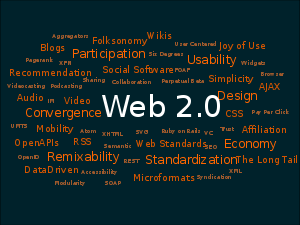 There is a wonderful phrase in film and TV script writing – ‘to jump the shark’. It’s that point in the history of a TV series where the scripts veer off in to the surreal or when characters suddenly change their behaviour. It’s reputedly named after an episode of the popular 1970s sitcom ‘Happy Days’ when the hero ‘The Fonz’ ends up jumping over a shark on water skies. Plausible, huh?
There is a wonderful phrase in film and TV script writing – ‘to jump the shark’. It’s that point in the history of a TV series where the scripts veer off in to the surreal or when characters suddenly change their behaviour. It’s reputedly named after an episode of the popular 1970s sitcom ‘Happy Days’ when the hero ‘The Fonz’ ends up jumping over a shark on water skies. Plausible, huh?
It struck me the yesterday, after seeing a site that had been bought to my attention via Twitter, that Web 2.0 may very well be at the point of jumping the e-shark.
Now, Web 2.0 has revolutionised the way we put web applications together. Before we go much further, Web 2.0 is like pornography; we know what it is when we see it but we’d be hard pressed to formally define it. So, here’s what I mean by Web 2.0. It’s a piece of jargon that is used to loosely define web sites and technologies that facilitate interactivity, inter-operability between web sites, sharing of user information and user driven content, whether text, image or multimedia content like video and animation. Web 2.0 sites are typically those where the content displayed to you and other site users can be easily modified and configured by the user. Facebook is a Web 2.0 ‘poster boy’; my Internet Banking site is good old fashioned ‘Web 1.0’.
A lot of the technology that has been developed to make Web 2.0 possible has found it’s way in to all sorts of Web sites – things like Google Apps, for example, are a perfect example of the serious application of Web 2.0 technologies.
But for all the value, have we finally hit a point where many sites and applications being delivered as part of the Web 2.0 revolution are trivial, absurd and effectively worthless to the vast majority of Web users, effectively showing themselves to be ‘portfolios’ for developers or sites of interest only to the digerati being passed off as the next ‘big thing’?
Not that there’s anything wrong with either of these directions, provided that we appreciate it and that we don’t get ourselves so tied up in having the joy of having a Web 2.0 site that we miss the point of what the site is supposed to be doing.
And so on to http://omegle.com/ . To save you the job of visiting, it’s a chat site that allows you to talk to….total strangers anonymously. Yes, a technology that trumpets the fact that it facilitates communications between individuals the world over now allows stranger to speak unto stranger. Maybe I’m a bit hard on this site, but to me it encapsulates so much of what is wrong with some of the more over-hyped Web 2.0 applications. It’s no doubt regarded as ‘cool’ and ‘clever’ by some; it’s essentially pointless, does little that can’t be done elsewhere. It’s almost ‘out of character’ for the original aim of Web 2.0 – to facilitate communication and interactivity. After all, anonymous communications are not that useful for most things. And you have to admit that talking to randomly selected anonymous people is pretty surreal. Assuming that the people on the other end are real people and not just ‘bot’ programs….
So…are we heading for Web 2.0 shark jumping in 2010? And why is it important?
Well, shark jumping almost always precedes the demise of the TV show. And it would be a shame if the good stuff that the interactive web has bought us were to be drowned under a wave of over-hyped nonsense.
